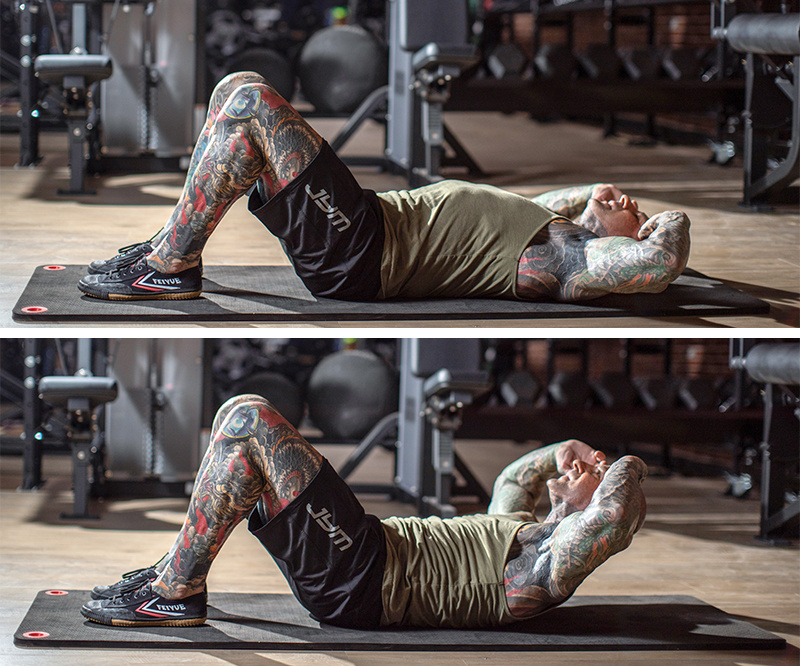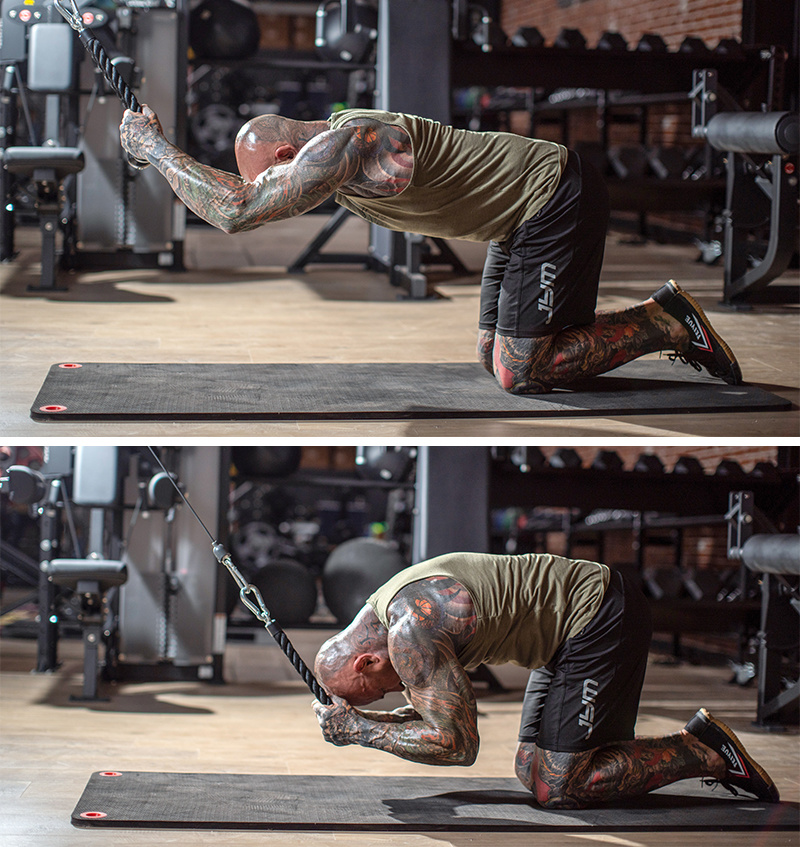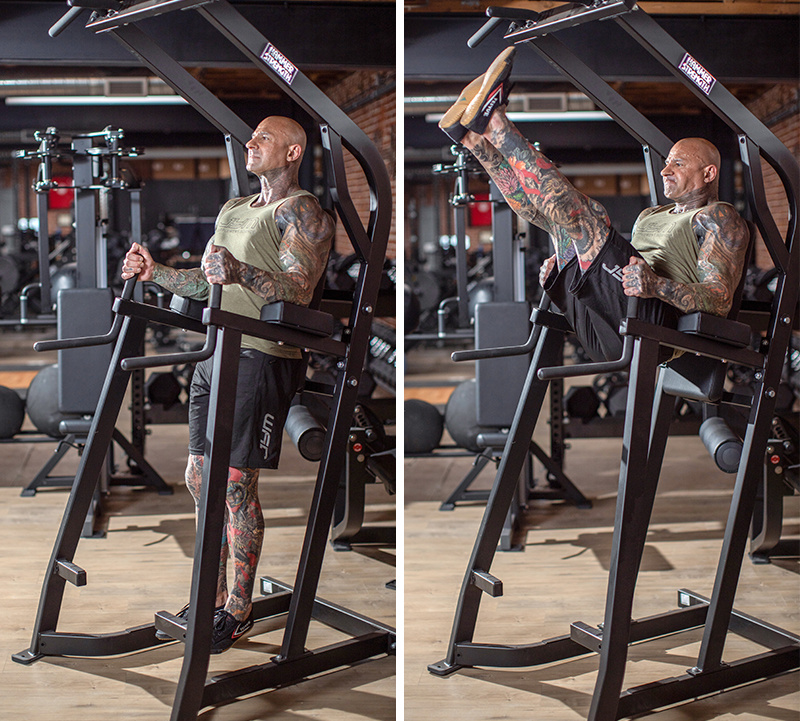5 Rules of Abs Training
Follow these guidelines in the gym for a better, more sculpted six-pack.

Follow these guidelines in the gym for a better, more sculpted six-pack.

Have you ever heard the saying, “Abs are made in the kitchen”?
Wrong!
Abs are NOT made in the kitchen. Abs are made (developed) through training. The nutrition component is simply what minimizes body fat in the midsection area to allow you to actually see the muscles you’ve developed.
And when it comes training the abs for a better six-pack and oblique striations running on either side of the “washboard,” I believe in 5 key principles. Here they are…
You can’t properly train a muscle if you don’t know what it is and what it does. When it comes to training the abs/midsection, here’s what we’re talking about in terms of anatomy…
There are four main muscles that make up the midsection. (When we talk about the “core,” many other muscles come into play, but here we’re focusing strictly on the front of the torso and sculpting a better six-pack.) The four muscles are the rectus abdominis, the internal obliques, the external obliques, and the transverse abdominis.
This, the “six-pack” muscle, is comprised of long fibers that run all the way down the front of the midsection and contract (shorten) to flex the spine, as in a sit-up or crunch. The rectus abdominis (especially the lower portion) also works to lift the pelvis, as in a reverse crunch or hanging leg/knee raise.
The oblique muscles are located on either side of the midsection and help to provide lateral stability in the torso. The important thing to note with the obliques is the diagonal direction in which their fibers run. The internal and external obliques actually run in opposite directions, though they work together.
The reason I say the diagonal direction is important to know is because to train a muscle optimally, you need to train muscle fibers in the direction that they’re running. This is precisely why oblique crunches are performed at an angle to one side or the other – when you do this “diagonal” crunch, it targets these diagonal-running oblique muscle fibers. The obliques are also targeted via lateral flexion of the torso, doing exercises like dumbbell side bends and cable oblique pushdowns.
When we go deep into the core musculature, we find the transverse abdominis, aka, the “Cumberbun muscle” because it runs horizontally across the midsection. The rectus abdominis is superficial (closer to the skin), which is why you can see the abs; the transverse abdominis is deep to the rectus, so it’s not visible.
Whereas the rectus abdominis flexes the spine and lifts the pelvis, and the obliques initiate lateral flexion and twisting motions, the transverse abdominis stabilizes the core in a more isometric fashion. When you contract your abs and pull your belly button in – the transverse abdominis is the muscle responsible for that specific “pulling in” action.
Now that we’ve gone over the specific muscles involved in building a better midsection, I’m going to divide it up into the four major areas we’re going to focus on in our training: upper abs, lower abs, obliques, and core.
Using these terms instead of the actual scientific names of the muscles is just a way to simplify things and make the language more applicable to training. Essentially what we’re doing is dividing up the rectus abdominis into two different parts (upper abs and lower abs); combining the internal and external obliques into one category (obliques), since, as I mentioned earlier, these diagonal fibers always work together; and lastly, giving the transverse abdominis the more common name of “core.”
Knowing your anatomy is one thing, but you also need to be able to feel the muscles working. If you can’t feel a muscle, you can’t contract it and develop it.
The key here is to really focus on the target muscle when you’re training it. For example, when you’re doing crunches, put all of your attention on the upper abs, feeling those muscles contract on every rep.
The upper abs are the easiest muscles to feel; establishing a good mind-muscle connection is a little tougher with the lower abs, obliques, and core. It takes time and practice, so just make sure you’re always directing your attention to the target area of the exercise you’re doing.
Before you establish a mind-muscle connection when doing ab exercises, however, work on contracting those muscles outside of the gym. One thing you can do to practice is to look at the muscles in a mirror while you contract them. When you’re at home, stand in front of the mirror with your shirt off and look at your upper abs while you flex your spine (crunch). Then, crunch to one side and look at your obliques and focus on them. Do that to both sides. As you do so, place your hand on the muscle to physically feel it contracting. Practice this often.
The transverse abdominis is too deep to see or feel with your hand, but you can still focus on those muscles while pulling your belly button in, or when you’re doing planks in the gym.

There are two ways to train a muscle: either by contracting it so it literally shortens or by doing an isometric hold. An example of this would be a crunch versus a plank. In both exercises, the abs are working. But they’re working in different ways – the muscles are shortening with the crunch, but not with the plank.
Many trainers will tell you that planks are the best way to train the abs. It’s gotten to the point where many so-called “experts” will tell you to never do crunches. This is TERRIBLE advice. You know why? Because the best way to develop a muscle is to shorten it. If you do all planks and no crunches for the abs, you’ll never be shortening the muscle! Crunches (pictured above) are a perfectly good abdominal exercise.
Yes, isometric planks will work the rectus abdominis (among other muscles), but because the muscle isn’t shortening, you won’t get full development of the muscle.
As I said earlier, the rectus abdominis flexes the spine and also lifts the pelvis. If you want to fully develop that muscle, you need to do exercises that flex the spine (upper abs), lift the pelvis (lower abs), and twist the torso (obliques). In other words, to fully develop the abs, you need to do crunching movements and leg lifts. These are exercises that actually shorten the target muscles. Planks serve the purpose of focusing on the deeper core muscles, not the upper abs, lower abs, or obliques.

One of the biggest fears people have when training the abs is that if they add resistance to exercises, it will make the abdominal muscles big and bulky and give them a bigger waistline. I’m talking about exercises like cable crunches (picture above), machine crunches, cable oblique crunches, and variations of crunches holding a weight plate or medicine ball.
Do NOT be afraid of building “big” abs. I want to be very clear on this point. You will NOT, and cannot, overdevelop the abs. It’s just not possible. You’re not going to make your waist bigger by training your abs with additional weight.
You know what makes your waistline bigger? A bad diet! Honestly, “Work on your diet” should probably be Rule #1 for better abs. But this is a training article, not a nutrition piece.
The abs are a muscle just like any other. They shorten and contract and get stronger with progressive overload. They respond well to heavy weight and low reps, light weight and high reps, and moderate weight and rep counts as well.
Not only should you not be afraid of adding weight to your ab exercises – you need to add resistance. You won’t be able to have that clear separation between the ab muscles without developing them.
The order in which you do your ab exercises matters. Go back to your abdominal anatomy – upper abs, lower abs, obliques, and core.
Generally speaking, here’s the order in which I recommend training abs when doing more than one exercise in a workout. For each area, I list common exercises for targeting it just so you know what specific movements I’m talking about.
The reason I recommend doing lower abs first is because this is the most common abdominal trouble spot for people. It depends on the person, of course, but generally speaking, the lower abs are a weak area, especially compared with the upper abs. Hanging leg raises, for example, are a far tougher exercise than a crunch, so you should do that movement when your muscles are at their freshest and strongest.

The order of upper abs and obliques is interchangeable – you can train oblique exercises before upper ab moves if you want to focus more on that area. The most important thing is that you do lower abs first and train the core last (or on a completely different day) a majority of the time.
Why the core last? Because those smaller, deep core muscles are fairly weak and don’t have much endurance. If you train the core first in your ab workout – say, with a plank – you’re going to fatigue those deep transverse abdominis muscles right off the bat.
The problem with that is, when you do exercises for the other areas, you’re still using those core muscles to stabilize the torso. If you’ve already fatigued them before doing hanging leg raises, you won’t be able as strong in that exercise; you’ll end up having to stop your set earlier because your core is fatigued. Personally, I’d much rather be able to do 3 sets of 20 hanging leg raises than 3 sets of 10-15 because my core is fried from doing planks already.
Save the deep core work for the end, or for a separate day.
Related Articles